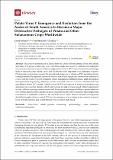Potato virus Y emergence and evolution from the Andes of South America to become a major destructive pathogen of potato and other solanaceous crops worldwide
Date
12/12/2020Grant ID
BB/L011840/1
BB/N023293/1
BB/P022553/1
Keywords
Metadata
Show full item recordAbstract
The potato was introduced to Europe from the Andes of South America in the 16th century, and today it is grown worldwide; it is a nutritious staple food eaten by millions and underpins food security in many countries. Unknowingly, potato virus Y (PVY) was also introduced through trade in infected potato tubers, and it has become the most important viral pathogen of potato. Phylogenetic analysis has revealed the spread and emergence of strains of PVY, including strains causing economically important diseases in tobacco, tomato and pepper, and that the virus continues to evolve with the relatively recent emergence of new damaging recombinant strains. High-throughput, next-generation sequencing platforms provide powerful tools for detection, identification and surveillance of new PVY strains. Aphid vectors of PVY are expected to increase in incidence and abundance in a warmer climate, which will increase the risk of virus spread. Wider deployment of crop cultivars carrying virus resistance will be an important means of defence against infection. New cutting-edge biotechnological tools such as CRISPR and SIGS offer a means for rapid engineering of resistance in established cultivars. We conclude that in future, human activities and ingenuity should be brought to bear to control PVY and the emergence of new strains in key crops by increased focus on host resistance and factors driving virus evolution and spread.
Citation
Torrance , L & Talianksy , M E 2020 , ' Potato virus Y emergence and evolution from the Andes of South America to become a major destructive pathogen of potato and other solanaceous crops worldwide ' , Viruses , vol. 12 , no. 12 , 1430 . https://doi.org/10.3390/v12121430
Publication
Viruses
Status
Peer reviewed
ISSN
1999-4915Type
Journal item
Description
Funding: This research was funded by the Scottish Government: Rural and Environment Science and Analytical Services Division (M.T. and L.T.), and BBSRC grants BB/L011840/1, BB/N023293/1, BB/P022553/1 to L.T. and the Government of Russian Federation Grant No. 14.W03.31.0003 to MT.Collections
Items in the St Andrews Research Repository are protected by copyright, with all rights reserved, unless otherwise indicated.

